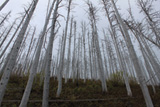“No human being, however great, or powerful, was
ever so free as a fish”
- John Ruskin, 1819 -1900
Fish
The seemingly endless miles of cold clear rivers, meandering streams, and hundreds of lakes of the biologically unique Flathead Watershed are home to 46 species of fish (including hybrids), of which 23 are native. Some of the native fish include westslope cutthroat trout, bull trout, lake trout, lake whitefish, mountain whitefish, pygmy whitefish, and grayling. Each species is native to specific lakes and rivers. While a small number of lakes have populations of fish that have been isolated for as long as 10,000 years, most of the watershed’s aquatic ecosystems include several introduced species of fish.
Nonnative fish were introduced at the urging of settlers who thought that fishless or “unproductive” lakes were broken and required fixing. Stocking for recreational anglers has been conducted for over 110 years, and continues in many areas today. Some of the fish that have been introduced (legally and illegally) over the years include bass, kokanee, perch, walleye, and brook, brown, and rainbow trout. Stocked fish are raised in local hatcheries and their stocking distribution is now mostly managed by biologists. Unfortunately non-native fish have altered the once stable aquatic environment in the Flathead Watershed and have endangered the health and existence of some native fish.
Bull trout and westslope cutthroat trout
These two fish are considered the lifeblood of the watershed because they have persisted in the system for over 14,000 years through numerous glaciations, fires, drought, flooding, and human development. Bull trout (Salvelinus confluentus) are an important indicator species for environmental disturbance due to their specific spawning and rearing habitat requirements and sensitivity of life history stages. They are Blue-Listed in British Columbia, and have been listed as threatened in the U.S. since 1998. The species requires clean, sediment-free rivers and streams to spawn. Bull trout are also adfluvial, which means they spawn and rear their young in tributaries to Flathead Lake, then move downriver to the lake to mature and live. Their spawning requirements concentrate the bull trout in a few streams and rivers, making those waterways important habitat to protect.
Westslope cutthroat trout (Onchorhynchus clarkii lewisi) is the species of cutthroat trout that is native to the Flathead Watershed. Like bull trout, they are an indicator species for environmental disturbance. They are also an indicator species for nonnative species disturbance as a result of their high incidence of hybridization with introduced species, and for overexploitation because of their high susceptibility to angling pressure. This fish now occupies approximately 19 - 27% of its historic range in the state of Montana. Habitat degradation, competition with introduced trout species, hybridization with introduced species, and a high intolerance to disturbances have all contributed to the decline in westslope cutthroat numbers. While they are not currently listed by the ESA, they are Blue-Listed in B.C. and listed as a Species of Concern by the Montana Heritage Program.
 |
 |
|
| The Flathead Watershed - A bull and Cutthroat Trout Stonghold, Clint Muhlfeld | Bull Trout in the Flathead Watershed, Wade Fredenburg, Craig Kendall |

